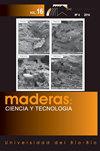五种巴塔哥尼亚真菌菌丝复合材料的评价
IF 1.5
4区 农林科学
Q3 MATERIALS SCIENCE, PAPER & WOOD
引用次数: 2
摘要
菌丝复合材料由颗粒状木质纤维素材料组成,例如,来自木材工业的木屑结构为由菌丝生长产生的固体基质。基于不同的菌株和基质,提出了许多方案。然而,菌丝体系结构等内在因素对工业所需主要参数的影响仍有待研究。这项工作的主要目的是评估五种巴塔哥尼亚木质纤维素降解真菌生产菌丝复合材料的性能。研究了这些菌种的菌丝结构与菌丝基材料菌丝结构的关系。用商业膨胀聚苯乙烯进行了Janka标度硬度的比较。侧耳菇、诺索菲菇和龙舌兰生长的复合材料成功形成复合材料,但质量低于南方灵芝。白垩纪的Ryvardenia也完全没有在基底上定居。由澳大利亚灵芝生长在松树锯末上产生的材料(根据其在当地的可用性选择的基质)被认为是一种具有提高抗性的良好替代品。菌丝系统,巴塔哥尼亚菌株,锯末基质。本文章由计算机程序翻译,如有差异,请以英文原文为准。
Evaluation of mycelium composite materials produced by five Patagonian fungal species
Mycelium composites consist of particulate lignocellulosic materials, e.g., sawdust from the timber industry structured as a solid matrix resulting from the mycelial growth. Many protocols have been proposed based on different strains and substrates. However, the influence of intrinsic elements, such as the structure of the hyphal system on the main parameters required by the industry still needs to be researched. The main goal of this work is to assess the performance of five Patagonian lignocellulolytic fungal species for producing mycelium composites. Strains of these species were studied in order to assess the relation between basidiome hyphal structure and the hyphal structure of mycelium-based materials. Comparisons of the hardness in the Janka scale were performed with commercial expanded polystyrene. Composites resulting from the growth of Pleurotus ostreatus , Nothophellinus andinopatagonicus and Funalia trogii successfully formed composites, showing a lower quality than Ganoderma austral. Ryvardenia cretacea in turn completely failed to colonize the substrate. The material resulting from the growth of Ganoderma australe on pine sawdust (a substrate chosen based on its local availability) is proposed as a good substitute with improved resistance. hyphal system, patagonia strains, sawdust substrate.
求助全文
通过发布文献求助,成功后即可免费获取论文全文。
去求助
来源期刊

Maderas-ciencia Y Tecnologia
工程技术-材料科学:纸与木材
CiteScore
2.60
自引率
13.30%
发文量
33
审稿时长
>12 weeks
期刊介绍:
Maderas-Cienc Tecnol publishes inedits and original research articles in Spanish and English. The contributions for their publication should be unpublished and the journal is reserved all the rights of reproduction of the content of the same ones. All the articles are subjected to evaluation to the Publishing Committee or external consultants. At least two reviewers under double blind system. Previous acceptance of the Publishing Committee, summaries of thesis of Magíster and Doctorate are also published, technical opinions, revision of books and reports of congresses, related with the Science and the Technology of the Wood. The journal have not articles processing and submission charges.
 求助内容:
求助内容: 应助结果提醒方式:
应助结果提醒方式:


